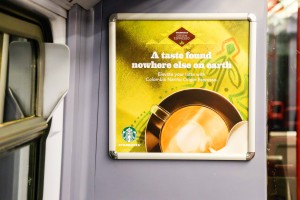On-train advertising has long been an element of marketing campaigns, but recent developments in the wider communications landscape have brought it centre stage. Increased connectivity on trains, faster browsing speeds, and wider acceptance of ecommerce, has led to a boom in on-train shopping. The link between advertising, purchase planning and the actual purchase has never been as strong.
But for advertisers to take full advantage of these trends they must understand consumer on-train behaviour. Recent research from mobile payment innovator Zapp helps demonstrate the extent and type of on-train purchases consumers make.
Over a fifth of all UK online shopping sales now takes place during a daily commute, accounting for £9.3bn in sales a year. The research also found that each commuter spends £36 a week on average rising to £44 for London commuters. Overall, the amount spent by commuters in the capital accounts for nearly two-thirds (£5.9bn) of the total spend nationally.
Clothing is the most popular purchase, with almost three quarters of train-using Brits (71%) buying clothes during their weekly train journey. Entertainment and media are also popular, with 68% of commuters paying for digital downloads, and 65% spending on other entertainment such as DVDs, CDs or books.
A recent study from KBH On-Train Media interviewed over 2000 rail users in a bid to drill down into what influences consumers to make purchases in this environment.
Firstly, the survey found that on-train advertising really does have an impact. Some 94% of respondents said they had noticed on-train ads, while 48% researched or looked up an advertised product or service. Some 33% had a conversation about an on-train ad they had seen and 24% made a purchase as a result of the advertising.
The research also found that the average dwell time of 38 minutes on the train gave consumers time to read and absorb on-train messaging, giving this type of advertising an advantage over other out-of-home formats.
As stated, connectivity is integral to on-train purchases and some 90% of commuters surveyed were connected to a smart phone on their journey. Of these, half their travel time was spent on the device. This connectivity meant consumers were able to both research and buy products promoted on the train once they had seen an ad.
Increasing consumer confidence around ecommerce has been another important driver of on-train purchases. And new social media developments, such as the Buy buttons on Facebook and Google will simplify the path to purchase and further drive online shopping. Surfing statistics show that Google and Facebook are regularly used by train travellers meaning opportunities for advertisers and brands to sell products or services through these channels are huge.
So how can advertisers capitalise on dwell time, connectivity and consumer acceptance of ecommerce? By recognising that purchasing decisions depend on the consumer’s mindset and the type of product advertised.
Consumers make both immediate and delayed decisions following exposure to on-train ads. The research found that the most popular time to buy a product or service seen advertised on a train was later that day, with 29% doing so. Some 28% purchased immediately, while a considerable 27% said they acted on the desire to purchase ‘a few days later’.
The value of purchase impacted the speed of action and advertisers should build understanding of this anticipated delay into their campaigns. Big-ticket items tend to be researched and discussed with ‘significant others’, and purchased later. Smaller items, such as fashion, provoked a more immediate response.
The advertiser should also ensure their message fits the commuter’s state of mind in the on-train environment. The train journey acts as a buffer zone between one part of the day and the next and is a time when consumers contemplate the next stage of their day and their wider interests and intentions. Advertisers that build understanding of this state of mind into their campaign will see most success.
Sky Difference launched an effective on-train campaign that recognised the commuter’s contemplative state of mind by prompting ideas for evening and weekend entertainment. Starbucks also thought about the time of day its ad would be seen and built on the anticipation of the commuter’s morning coffee.
The combination of connectivity, dwell time and acceptance of ecommerce provides on-train advertisers with a unique opportunity to reach potential consumers during their commute. And those advertisers able to understand the nature of purchasing decisions as well as match their message to the commuter’s mind-set will be best positioned to capitalise on the surge in commerce on-the-go.






